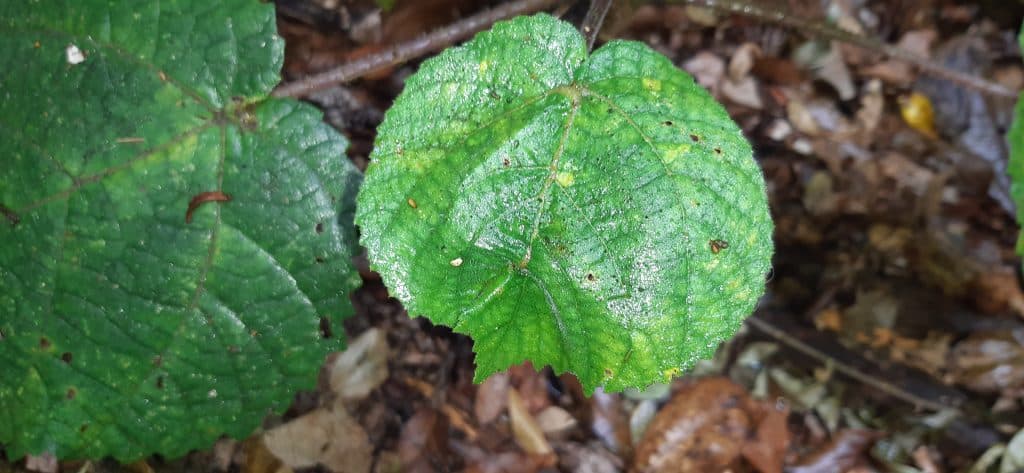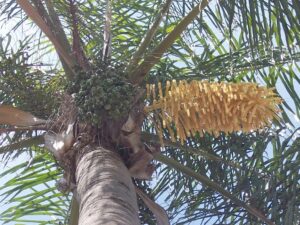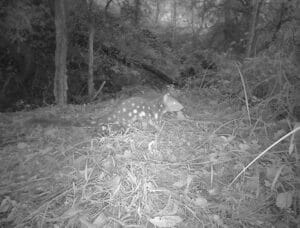
Tourists often ask whether everything here wants to kill them…we have the world’s deadliest snakes, spiders, jellyfish, octopus – you name it – and even some of our plants can be dangerous if not lethal!
The Giant Stinging Tree (Dendrocnide excelsa) occurs along the east coast of Australia and can be seen throughout Wingham Brush and other rainforest areas within the Manning Valley. It’s a medium to large tree, up to 40m tall and 6m around the buttressed base. It has smooth grey bark and a fluted trunk, with very large heart-shaped leaves up to 30cm across in the shade. The leaves have a toothed edge and are covered in minute hollow silica stinging hairs, each acting like a tiny hypodermic syringe to inject toxin. In fact, all parts of the tree are covered in these hairs including the trunk, stems, branches, and flower stems, although as the tree matures, the trunk and branches lose some of their stinging hairs and the leaves may become smaller and less venomous.
When does it flower?
The tree flowers from November to April and the fruit is a purplish or blackish nut and is a favourite of rainforest birds. The tree is an important part of rainforest ecology and often grows along rainforest edges and disturbed areas where it receives more sunlight.
When touched, the stinging hairs break off in your skin and can cause a severe reaction to humans, pets and livestock. It has been reported that dogs and horses have died from brushing against the leaves, and at least one human death has been reported. However native animals including possums, pademelons, insects, fruit bats and birds frequently graze on the leaves and fruit and are an important method of seed dispersal. So why has this tree developed such lethal toxins if native animals are unaffected? Scientists have theorized the tree developed these toxins in response to the extensive grazing of the megafauna, between 11 million and 46,000 years ago. The species we have now which can eat the tree evolved so the toxins do not harm them. Humans and other animals such as livestock have not been here long enough to develop a tolerance.
Toxic properties
The hairs contain neurotoxic proteins named gympietides, similar to those found in spiders and cone snails, and it binds to the pain receptors in the nervous system, causing them to continually fire off messages to the brain. Scientists think it is possible that the neurotoxins cause permanent changes to the sensory neurons. Pain from a very light brush of the hairs may last a few hours, and vary from a painful tingling to extreme pain, depending on the individual. Severe stings may last for months or possibly even years, returning at random and causing a thickened red swollen area covered in red spots. Pain may also be referred to other areas of the body. Some individuals may also suffer anaphylactic shock and be unable to breathe and hospitalisation may be necessary. Children may be more susceptible to severe reactions.
What to do and treatment
Prevention is the best cure! Researchers found even wearing welding gloves did not protect them. If you have these trees on your property – do not touch them – even out of curiosity – fence them off from your livestock, and do not take your dog for a walk near them. Do not try to cut them down with a chainsaw as they are extremely pulpy and fibrous.
The current recommended first aid treatment is to cover the affected area with hot wax hair-removal strips and rip them off, hopefully taking the stinging hairs with it. Do not reuse the wax! If you don’t have wax, try sticking plaster. It WILL hurt. Do not rub the area, do not apply heat or cold, do not apply creams – any rubbing will break off the hairs in the skin and make it worse. Many old-timers had remedies such as rubbing the inside of the bark on the sting but none of these have been shown to actually work.
The good news? The Giant Stinging Tree is not the worst – this title belongs to the Gympie Stinger, described by one researcher as “the worst kind of pain you can imagine – like being burnt with hot acid and electrocuted at the same time”… luckily these grow further north!
Take care out there!
References:
https://en.wikipedia.org/wiki/Dendrocnide_excelsa
https://www.discovery.com/nature/Suicide-Plant
https://www.childrens.health.qld.gov.au/poisonous-plant-stinging-tree-dendrocnide-excelsa/
Photos: L.Booth – Stinging Trees in Wingham Brush




